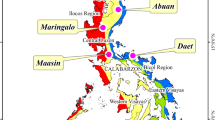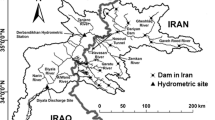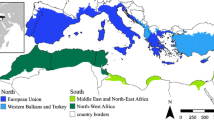Abstract
Considering changes in irrigation planning and development due to climate change is necessary to avoid system failure. This study demonstrated that changes in dependable flow and diversion water requirements in the future due to climate change will reduce potential irrigable areas. Climate change were based on the published projected climate in the study area. The dependable flow derived from successfully calibrated and validated Soil and Water Assessment Tool (SWAT) model streamflow simulations and the diversion water requirements based on the CROPWAT estimations of irrigation scheme were used to assess the potential irrigable areas. Substantial reductions in potential rice production areas (-4% to – 39%) were largely due to dwindled dependable flow (-1% to -25%) and an increase in diversion water requirement (+ 7% to + 26%). Reduction in potential irrigable area was projected during dry and normal years and may worsen towards the late twenty-first century under the worst-case climate scenario. Swelling of rivers during wet years will increase stream flows and potential irrigable areas but may also pose a danger of flooding. The development of water storage structures is necessary to reduce the adverse impacts of too much water during the wet years. Crop calendars should also be retrofitted to optimize the use of available rainfall during dry and normal years and climate-proof future irrigation systems. The results showed that it is necessary to incorporate climate change in irrigation planning and development. The methodologies described here could be used to climate-proof future irrigation systems in other areas in the Philippines and other countries.



Similar content being viewed by others

Availability of Data and Materials
All the data are available upon request in responsible agencies.
References
Abansi CL, Hall RA, Siason IML (2018) Water demand management and improving access to water. Glob Issues Water Policy 8:233–259. https://doi.org/10.1007/978-3-319-70969-7_11
Abbaspour KC (2015) SWAT‐CUP: SWAT calibration and uncertainty programs - a user manual
Alejo LA (2020) Assessing the impacts of climate change on aerobic rice production using the DSSAT-CERES-Rice model. J Water Clim Change. https://doi.org/10.2166/wcc.2020.286
Alejo LA, Ella VB (2019) Assessing the impacts of climate change on dependable flow and potential irrigable area using the SWAT model. The case of Maasin River watershed in Laguna, Philippines. J Agric Eng 50:88–98. https://doi.org/10.4081/jae.2019.941
Alejo LA, Ella VB, Lampayan RM, Delos Reyes AA (2021) Assessing the impacts of climate change on irrigation diversion water requirement in the Philippines. Clim Change 165:1–17. https://doi.org/10.1007/s10584-021-03080-6
Araza A, Perez M, Cruz RVO et al (2020) Probable streamflow changes and its associated risk to the water resources of Abuan watershed, Philippines caused by climate change and land use changes. Stoch Env Res Risk Assess. https://doi.org/10.1007/s00477-020-01953-3
Bareng JLR, Balderama OF, Alejo LA (2015) Analysis of irrigation systems employing comparative performance indicators: A benchmark study for national irrigation and communal irrigation systems in Cagayan River Basin. J Agric Sci Technol A 5:325–335. https://doi.org/10.17265/2161-6256/2015.05.003
Baronchelli A, Ricciuti R (2018) WIDER Working Paper 2018/86: Climate change, rice production, and migration in Vietnamese households
Briones RU, Ella VB, Bantayan NC (2016) Hydrologic impact evaluation of land use and land cover change in Palico Watershed, Batangas, Philippines Using the SWAT model. J Environ Sci Manag 19:96–107
David WP (2000) Constraints, opportunities and options in irrigation development
Falkenmark M (2008) Water and sustainability: A reappraisal. Environment 50:4–16
Food and Agriculture Organization (1976) A framework for land evaluation, FAO Soils. Food and Agriculture Organization of the United Nations, Wageningen, Netherlands
Food and Agriculture Organization (1985) Evaluating and classifying land for irrigated agriculture. In: Guidelines: Land evaluation for irrigated agriculture, FAO soils. Soils Resources, Management and Conservation Service FAO Land and Water Development Division, Rome, Italy
Gassman PW, Reyes MR, Green CH, Arnold JG (2007) The soil and water assessment tool : Historical development, applications, and future research directions. Trans ASAE 50:1211–1250. https://doi.org/10.13031/2013.23637
Gleick PH (2003) Global freshwater resources: Soft-path solutions for the 21st century. Science 302:1524–1528
Gupta RS (2017) Hydrology and hydraulic systems, 4th edition
Inocencio A, Barker R (2018) Current challenges in agricultural water resource development and management in the Philippines. DLSU Bus Econ Rev 28:1–17
Inocencio AB, Briones RM (2020) Irrigation investments: Some recurrent and emerging issues
International Fund for Agricultural Development (2014) Vietnam’s rice production threatened by climate change
Kontgis C, Schneider A, Ozdogan M et al (2019) Climate change impacts on rice productivity in the Mekong River Delta. Appl Geogr 102:71–83. https://doi.org/10.1016/j.apgeog.2018.12.004
Luyun RA, Elazegui DD (2020) Assessing the resurgent irrigation development program of the Philippines-communal irrigation systems component
Martínez-Salvador A, Conesa-García C (2020) Suitability of the SWAT model for simulating water discharge and sediment load in a Karst Watershed of the Semiarid Mediterranean Basin. Water Resour Manag 34:785–802. https://doi.org/10.1007/s11269-019-02477-4
Mehrazar A, Massah Bavani AR, Gohari A et al (2020) Adaptation of Water Resources System to Water Scarcity and Climate Change in the Suburb Area of Megacities. Water Resour Manag 34:12 34:3855–3877. https://doi.org/10.1007/S11269-020-02648-8
Moriasi DN, Arnold JG, van Liew MW et al (2007) Model Evaluation Guidelines for Systematic Quantification of Accuracy in Watershed Simulations. Transactions of the ASABE 50:885–900. https://doi.org/10.13031/2013.23153
Nash JE, Sutcliffe JV (1970) River flow forecasting through conceptual models part I-A discussion of principles. J Hydrol 10:282–290. https://doi.org/10.1016/0022-1694(70)90255-6
National Irrigation Administration (2020) Status of irrigation development. In Definition of Technical Terms. http://region11.nia.gov.ph/?q=node/11. Accessed 17 Mar 2020
Nigussie G, Moges MA, Moges MM, Steenhuis TS (2019) Assessment of suitable land for surface irrigation in ungauged catchments: Blue Nile Basin. Ethiopia Water 11:1465. https://doi.org/10.3390/w11071465
NOAA Climate Prediction Center (2019) Historical El Nino/La Nina episodes (1950-present). Historical El Nino/ La Nina episodes. https://origin.cpc.ncep.noaa.gov/products/analysis_monitoring/ensostuff/ONI_v5.php. Accessed 1 Mar 2019
Palao LKM, Dorado MM, Anit KPA, Lasco RD (2013) Using the soil and water assessment tool (SWAT) to assess material transfer in the layawan watershed, Mindanao, Philippines and its implications on payment for ecosystem services. J Sustain Dev 6:73–88. https://doi.org/10.5539/jsd.v6n6p73
Philippine Atmospheric Geophysical and Astronomical Services Administration (2018) Observed climate trends and projected climate change in the Philippines. Quezon City, Philippines
Pulhin J, Ibabao R, Rola A, Cruz R (2018) Water supply and demand and the drivers of change. Glob Issues Water Policy 8:15–40. https://doi.org/10.1007/978-3-319-70969-7_2
Rani S, Sreekesh S (2019) Evaluating the responses of streamflow under future climate change scenarios in a Western Indian Himalaya Watershed. Environ Process 6:155–174. https://doi.org/10.1007/S40710-019-00361-2
Santhi C, Arnold JG, Williams JR et al (2002) Validation of the SWAT model on a large river basin with point and nonpoint sources. J Am Water Resour Assoc (JAWRA) 37:1169–1188
Shi P, Chen C, Srinivasan R et al (2011) Evaluating the SWAT model for hydrological modeling in the Xixian Watershed and a comparison with the XAJ Model. Water Resour Manag 25:2595–2612. https://doi.org/10.1007/s11269-011-9828-8
Soltani A, Hoogenboom G (2003) A statistical comparison of the stochastic weather generators WGEN and SIMMETEO. Climate Res 24:215–230. https://doi.org/10.3354/cr024215
Srinivasan R, Ramanarayanan TS, Arnold JG, Bednarz ST (1998) Large area hydrologic modeling and assessment part II: Model application. J Am Water Resour Assoc 34:91–101. https://doi.org/10.1111/j.1752-1688.1998.tb05962.x
Tabios GQ, de Leon TZ (2020) Assessing the Philippine irrigation development program. PIDS Policy Notes 2020–02
Van Liew MW, Arnold JG, Garbrecht JD (2003) Hydrologic simulation on agricultural watersheds: Choosing between two models. Trans ASAE 46:1539–1551
Viola F, Feng X, Caracciolo D (2019) Impacts of Hydrological Changes on Annual Runoff Distribution in Seasonally Dry Basins. Water Resour Manag 2019 33:7 33:2319–2333. https://doi.org/10.1007/S11269-019-02250-7
Worqlul AW, Collick AS, Rossiter DG et al (2015) Assessment of surface water irrigation potential in the Ethiopian highlands: The Lake Tana Basin. CATENA 129:76–85. https://doi.org/10.1016/j.catena.2015.02.020
Worqlul AW, Jeong J, Dile YT et al (2017) Assessing potential land suitable for surface irrigation using groundwater in Ethiopia. Appl Geogr 85:1–13. https://doi.org/10.1016/j.apgeog.2017.05.010
Yu B, Zhu T, Breisinger C, Hai NM (2010) Impacts of climate change on agriculture and policy options for adaptation the case of Vietnam
Acknowledgements
The DOST – Engineering Research and Development for Technology, the DOST – Science Education Institute, the DOST – Philippine Council for Agriculture, Aquatic and Natural Resources Research and Development, and the Department of Agriculture – Bureau of Agricultural Research funded and supported this research. The authors would also like to thank the technical data support of the following agencies: Department of Public Works and Highways, National Mapping and Resource Information Authority, Philippine Atmospheric, Geophysical and Astronomical Services Administration, Isabela State University, and World Wide Fund for Nature-Philippines, as well as Ms. Marissa H. Valdez for proofreading this paper.
Funding
This research was funded and supported by the DOST – Engineering Research and Development for Technology, DOST- Science Education Institute, DOST- Philippine Council for Agriculture, Aquatic and Natural Resources Research and Development, and Department of Agriculture-Bureau of Agricultural Research.
Author information
Authors and Affiliations
Contributions
L.A. Alejo conceptualized and designed the study, as well as supervised and prepared the article. A.S. Alejandro gathered data, conducted analysis, and participated and contributed in the preparation and writing of the article.
Corresponding author
Ethics declarations
Ethical Approval
None of the authors conducted any human or animal experiments for this publication.
Consent to Participate
Not applicable.
Consent to Publish
Not applicable.
Competing Interests
The authors have no relevant financial or non-financial interests to disclose.
Additional information
Publisher's Note
Springer Nature remains neutral with regard to jurisdictional claims in published maps and institutional affiliations.
Rights and permissions
About this article
Cite this article
Alejo, L.A., Alejandro, A.S. Changes in Irrigation Planning and Development Parameters Due to Climate Change. Water Resour Manage 36, 1711–1726 (2022). https://doi.org/10.1007/s11269-022-03105-4
Received:
Accepted:
Published:
Issue Date:
DOI: https://doi.org/10.1007/s11269-022-03105-4



